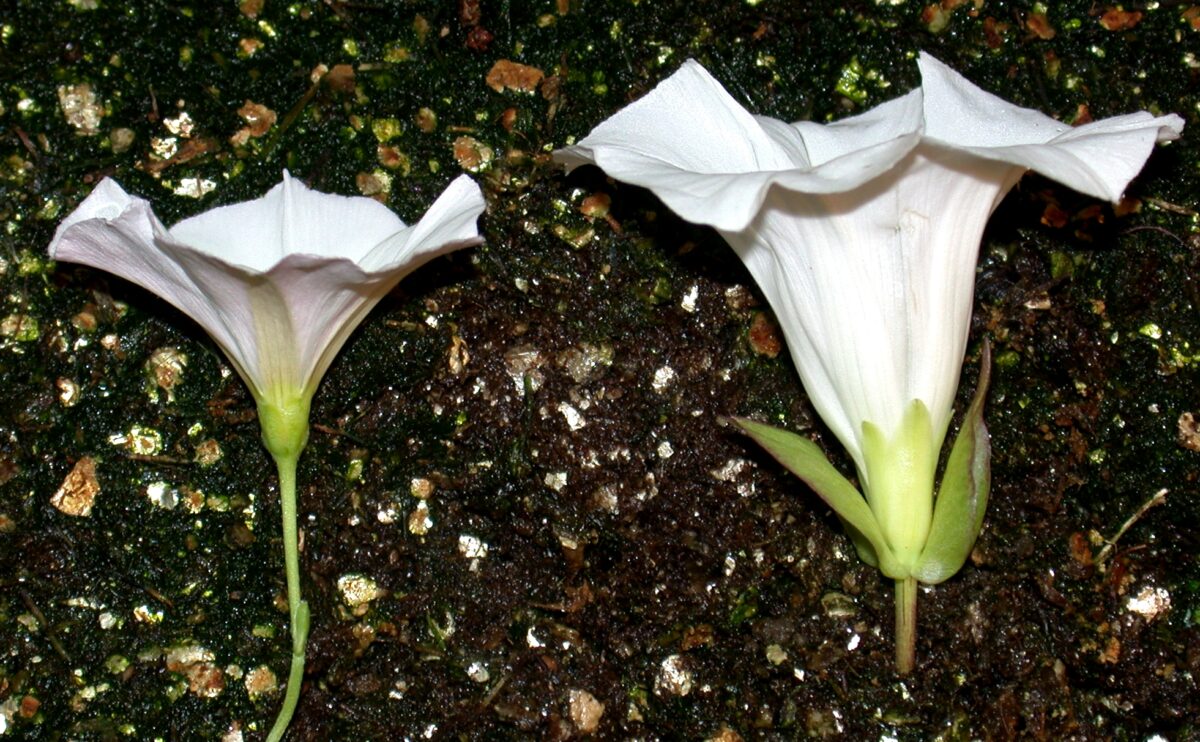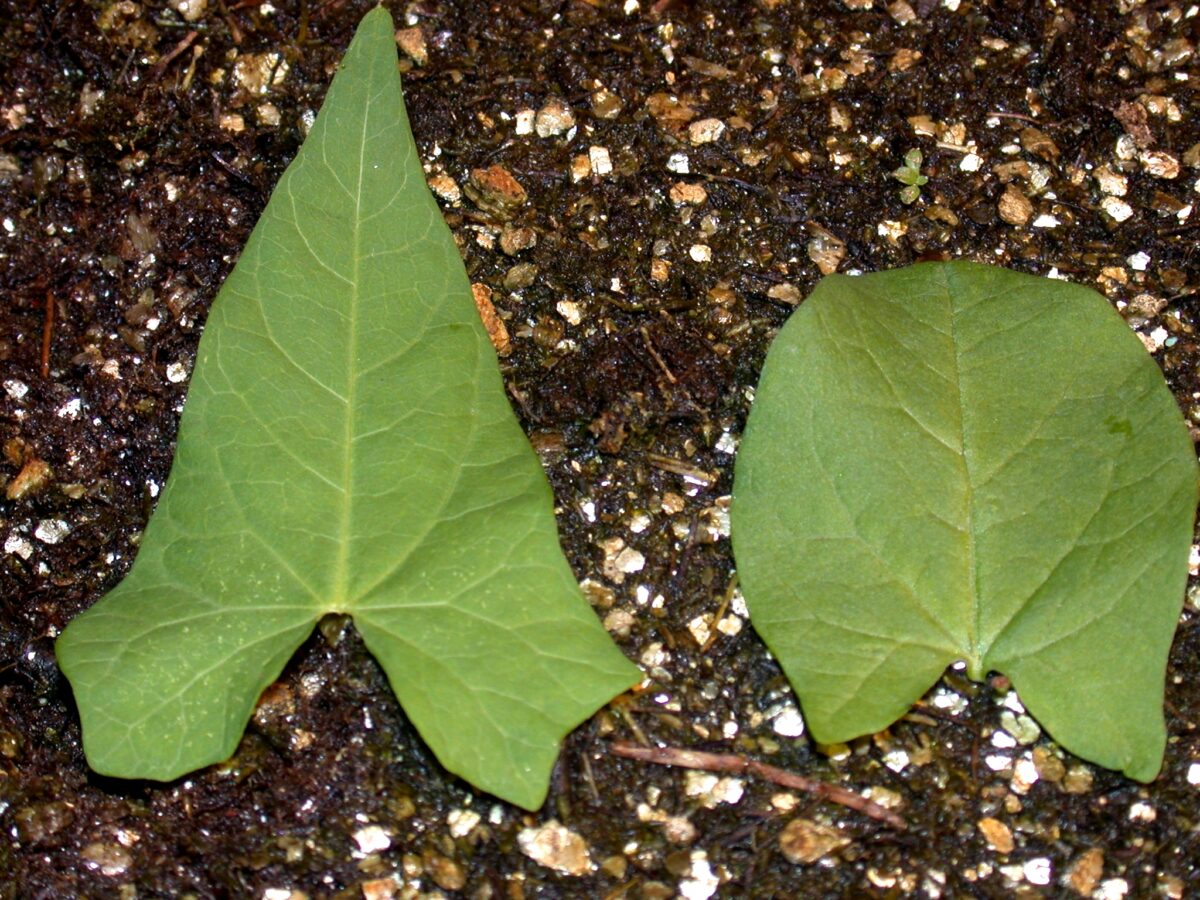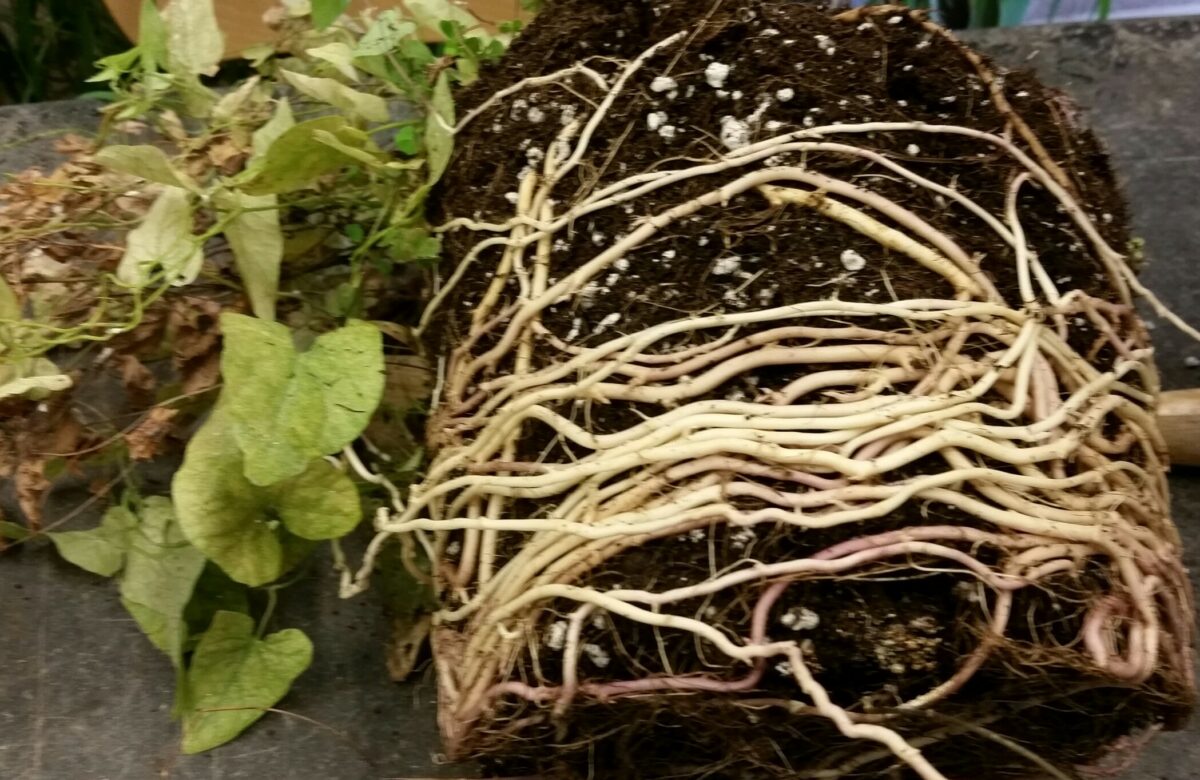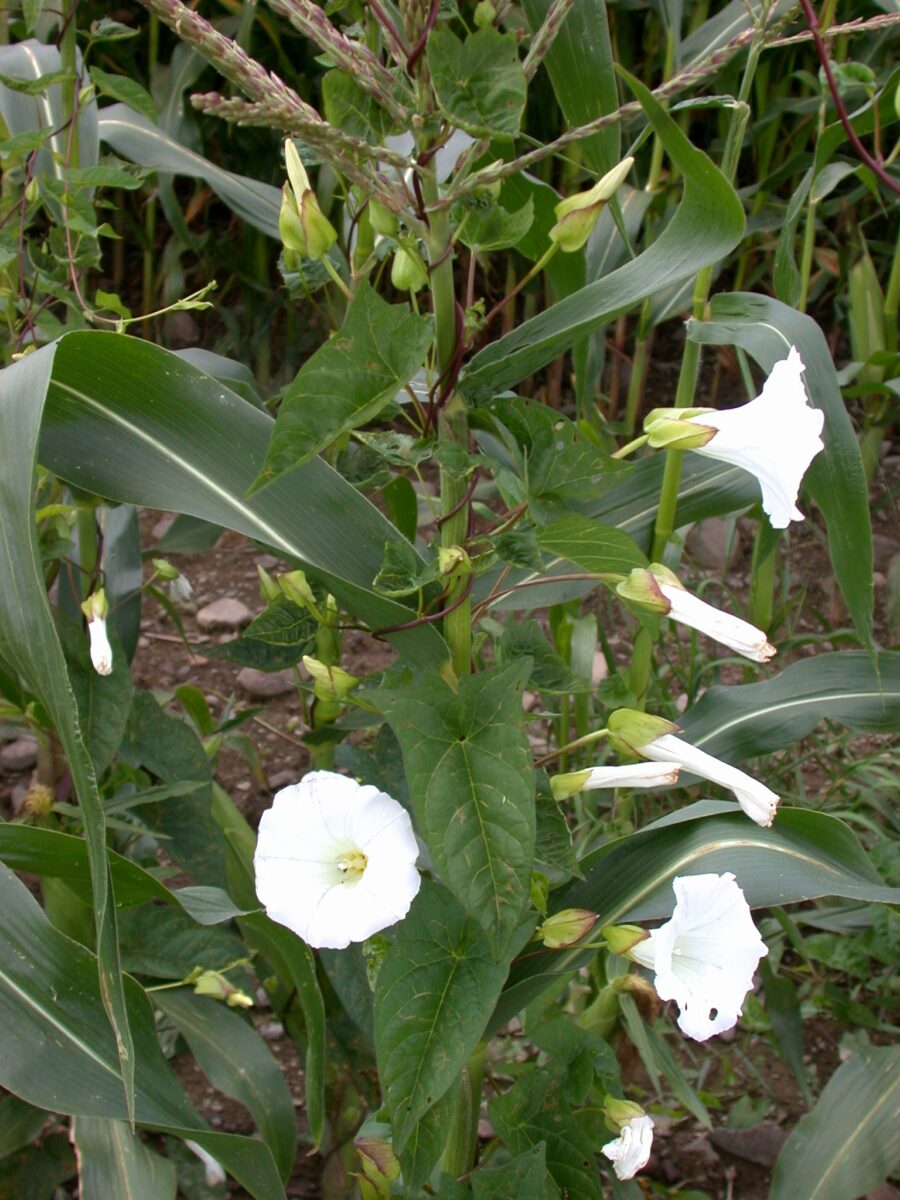Other common names:
- Field bindweed: bindweed, European bindweed, lesser bindweed, corn bind, possession bind, bear bind, cornbine, barbine, European glorybind, field morningglory, orchard morningglory, wild morningglory, small-flowered morningglory, creeping jenny, green vine, devil’s guts, corn lily, laplove, hedge bells
- Hedge bindweed: great bindweed, bracted bindweed, wild morningglory, devil’s vine, Rutland beauty, hedge lily




Field bindweed, Convolvulus arvensis L.
Hedge bindweed, Calystegia sepium (L.) R. Br.
Identification of Bindweeds
Family: Morningglory family, Convolvulaceae
Habit: Twining perennial herb spreading by thickened horizontal roots
Description: Vegetative sprouts arise from storage roots, lack cotyledons and have normal leaves, although the first leaves that form as the shoot is just pushing out of the soil are often deformed. Seedlings are much less common than vegetative sprouts.
- Field bindweed: Cotyledons are 0.35–0.87 inch long by 0.14–0.4 inch wide, long stalked, dark green with many white veins, square to heart- or kidney shaped, with lobes pointing toward the stem and an indented tip. Stems are red near the soil line. First leaves are bell shaped with basal lobes pointing outward.
- Hedge bindweed: Cotyledons are 1–2 inches long by 0.5–1 inch wide, have strong veins on the underside, and concave or flat tips and backwards extending, rounded lobes at the base. The stem may be red at the base. First leaves are arrow or heart shaped.
Mature plants run along the ground and twine up other plants. Stems may be hairy or hairless and smooth.
- Field bindweed: Leaves are alternate, 1.5–2.5 inches long, spade or arrow shaped, and borne on a long stalk. Lobes are triangular, with rounded ends. Roots can extend over 20 feet deep and run laterally up to 25 feet, forming large clones.
- Hedge bindweed: Leaves are alternate, 1.5–6 inches long, heart or arrow shaped, and pointed at the tip. Lobes are squarish when laid flat. Roots extend up to 1 foot deep and run laterally up to 9 feet, forming large clones.
Flowers are white or pink and are petunia shaped in both species.
- Field bindweed: Flowers are grouped one to five to a leaf axil and measure 0.5–1 inch across. Leafy bracts at the base of the flower are less than 0.1 inch long.
- Hedge bindweed: Flowers are single in leaf axils and measure 1.25–3 inches across. Bracts are heart shaped, 0.25–0.75 inch long and overlap and hide the flower base.
Fruit and seeds: Both field and hedge bindweed have round or egg-shaped capsules with two chambers, each containing one to two seeds. Seeds are gray-brown to black, with two flat sides and one rounded side.
- Field bindweed: Capsules are 0.31 inch in diameter. Seeds are 0.12–0.16 inch long and coarsely bumpy.
- Hedge bindweed: Capsules are 0.31 inch in diameter and is hidden by remnant flower bracts. Seeds are 0.16–0.20 inch long and slightly rough.
Similar species: Wild buckwheat (Polygonum convolvulus L.) has a papery covering extending up the stem from each leaf axil, long tapering leaf tips and long clusters of small, greenish flowers.
A note on development: The seedling develops a taproot from which thickened, permanent lateral roots arise. After growing laterally for 15–30 inches, these bend downward to form secondary taproots. At the bend, a vertical rhizome develops that grows to the soil surface to become a new shoot, and one or more new lateral roots continue the outward spread of the plant. Occasionally, rhizomes and subsequent shoots also develop from buds on the horizontal thickened roots. In undisturbed conditions, most of the thickened horizontal roots are in the top 6 inches of soil. Feeder roots form on both horizontal roots and taproots. In a deep silt loam soil in Kansas, a field bindweed plant spread laterally over 10 feet from the point of germination in seven months and had roots penetrating to nearly 4 feet. By the end of a third growing season, the plant had spread outward more than 16 feet and had roots penetrating as much as 23 feet.
Management of Bindweeds
The bindweeds cause severe problems in many crops. The extensive and efficient root system of field bindweed can reduce soil water content to below the wilting point of most crops. Hedge bindweed is more upright in its early growth than field bindweed and is quicker to climb up crop plants. Both species are strong competitors and cause harvesting problems for grain and for both hand harvested and mechanically harvested vegetables.
Winter grains and early planted spring grains suffer less from bindweed competition than do summer crops because their primary period of water use occurs before bindweed is well established. If a fallow period prior to planting suppresses the bindweed in the fall, winter grains will cast enough shade in the spring to effectively suppress field bindweed. Similarly, if your soils do not allow early tillage, use a vigorous fall planted cover crop to compete with bindweed in the spring. Alfalfa can suppress bindweed by dense shading and repeated mowing. Summer planted cover crops also can be effective, but choose species that develop a dense leaf canopy and plant them at high density. In one study, forage soybeans planted July 1 in Minnesota killed every shoot of field bindweed, whereas less-shade-producing covers did not. Sudangrass and German millet were also relatively effective. For vegetable farmers that are not land limited, a sequence of cover crops such as overwintered rye, oats plus peas, then buckwheat or sorghum-sudangrass, and finally overwintered rye plus hairy vetch, with disking before planting each cover crop, will suppress bindweed and prepare the field for a good vegetable crop.
Repeated shallow tillage during fallow periods between crops is also important for controlling bindweed. Root reserves reach a minimum when the shoot is about 12–28 inches long and has four to six fully expanded leaves, and plants are probably most sensitive to cultivation at that stage of development. Full eradication by tillage alone usually requires continuous fallow for two full growing seasons, with shallow tillage every 12–20 days. Usually, such extreme measures are not economically feasible or environmentally desirable. Shorter fallow periods, however, can be worked into the crop rotation either before late planted crops or after early harvested crops. These will not eliminate bindweed but can greatly reduce its density and competitiveness. Note that the amount of soil moisture (affected by rainfall or irrigation) plays an important role in the effectiveness of fallow and repeated tillage. Untimely rainfall or poorly planned irrigation can allow bindweed to persist when managing it with repeated tillage or fallow.
Begin inter-row cultivation of row crops as soon as possible, since tine weeders and rotary hoes are ineffective against young bindweed shoots. A tine weeder can be used, however, to comb larger bindweed shoots out of row crops, but at the cost of some damage to the crop and considerable labor cleaning the weeder. Continue inter-row cultivation as long as you can get through the crop. Use low-pitch half sweeps or vegetable knives set shallowly to cut off bindweed close to the row without damaging crop roots. If bindweed stems are longer than about 8 inches, avoid using rotary tillers, spyders or rolling cultivators, as the vines will spool up on the implement and you will spend more time cleaning the equipment than actually cultivating. Avoid spreading bindweed by scraping off tillage and cultivation implements after working in infested areas. Grazing by sheep, cattle and chickens will suppress aboveground growth and thereby help deplete storage reserves in the roots. Pigs will grub out roots and rhizomes from the plow layer.
Organic mulch is completely useless against these species: We have observed hedge bindweed shoots emerging through an 18-inch thick pile of bark mulch that was waiting to be spread! Synthetic mulch can suppress field bindweed, but it is relatively ineffective against hedge bindweed, since the vines will follow light to the planting holes. This puts the vines in an optimal position for twining up the crop plants and makes hand pulling difficult. Interseeding clover into corn at last cultivation did not control hedge bindweed, but it reduced the height of climbing stems by half and the length of creeping stems by 72%.
Although the bindweeds are difficult to manage, many growers keep them below damaging levels through good crop rotation and persistent cultivation. An integrated program of non-chemical control tactics can provide equivalent control to that obtained using herbicides. We know one vegetable farm that successfully eradicated a bad infestation of hedge bindweed over a three-year period by supplementing mechanical cultivation with consistent hand weeding.
Ecology of Bindweeds
Origin and distribution: Field bindweed probably originated in the Mediterranean region of Europe, Asia and North Africa but now occurs widely on those continents and has been introduced into North and South America, Australia and the Pacific Islands. Hedge bindweed is native to Eurasia, Africa and eastern North America, and it has been introduced into New Zealand. Both species occur throughout the United States and southern Canada.
Seed weight: Field bindweed: 8–20 mg; hedge bindweed: 28–34 mg.
Dormancy and germination: Both species have hard seed coats that prevent absorption of water. Consequently, only 5–25% of freshly collected field bindweed seeds will germinate, and no fresh hedge bindweed seeds will germinate. Damage to the seed coat (scarification) leads to 100% germination in both species. Overwintering in soil tends to soften the spot where the seed attached to the parent plant and increases the germination ability of hard seeds by 30%. Scarified seeds of field bindweed germinate over a wide range of temperatures, from 41–104°F, but percentage germination and speed of germination are greatest at a day/night temperature of 95/68°F. The seeds do not require light for germination. Similarly, 100% of scarified hedge bindweed seeds germinate within one week at day/night temperature regimens ranging from 59/43°F to 77/68°F. Scarified seeds all germinate within about one month. Unscarified hedge bindweed seeds germinated slowly, with 30–60% germinating within six months, depending on temperature. Unscarified seeds germinate best at a day/night temperature of 77/59°F.
Seed longevity: These species form long-term, persistent seed banks with some seeds remaining viable in the soil for at least 20 years. Burial of field bindweed seeds for a single growing season reduced number of intact seeds by 17–40%.
Season of emergence: Shoots from overwintering roots begin emerging in mid-spring and continue emerging throughout the growing season. Seedlings of field bindweed are most abundant in late spring and early summer but continue to emerge throughout the growing season.
Emergence depth: Most roots are found in the top 2 feet of soil, with the highest concentration in the top 6 inches. Accordingly, it is reasonable that emergence from vegetative root tissue occurs primarily from up to 6 inches. Seedlings of field bindweed emerge readily from anywhere in the top 2.4 inches of soil, and 10% of seeds at 4 inches will produce seedlings. Seedlings will usually not emerge from 4.7 inches. Hedge bindweed seeds are larger, and seedlings may emerge from even deeper in the soil.
Photosynthetic pathway: C3
Sensitivity to frost: The aboveground shoot dies back from frost, but the roots withstand temperatures as low as 21°F.
Drought tolerance: Field bindweed can survive long periods of drought due to its deep root system. When watering frequency was reduced from daily to once per week, shoot and root production by field bindweed seedlings was about halved; shoot production by plants grown from root segments was similarly about halved, but root production of plants grown from root segments was scarcely reduced. With its shallower root system, hedge bindweed may be more susceptible to drought than field bindweed.
Mycorrhiza: Both species are mycorrhizal.
Response to fertility: The limited information available indicates that field bindweed is favored by additions of P and K but tends to be out-competed by N responsive species when N or a balanced nutrient source is used. Weight of twining vines was about twice as great when hedge bindweed was grown in compost and loam as when grown in sand, but productivity of surface runners and belowground parts differed little.
Soil physical requirements: Field bindweed does best on good agricultural soils, but it is also common on sandy soils. It does not tolerate waterlogged soils. In contrast, hedge bindweed is highly tolerant of water-logged conditions and invades wetlands.
Response to shade: The bindweeds are moderately sensitive to shade. Reducing light by 55% reduced root growth by 35% and shoot growth 60%. In 80% shade, field bindweed shoot dry weight was reduced by 25–30% but stem length about doubled. Under heavy shade (95%), leaf weight decreased 39% but leaf area increased 36%, allowing the plant to continue to grow. With dense shade from a competitive crop, however, field bindweed cannot climb. The 98% shade cast by forage soybeans killed all shoots of field bindweed, and heavy shading cover crops of rye, oats and sudangrass suppressed growth substantially. Both species overcome moderate shade by climbing on crop plants.
Sensitivity to disturbance: These species are extremely resistant to soil disturbance because the root system penetrates below the plow layer, and new shoots can emerge from as deep as 2 feet. Tillage implements fragment roots and vertical rhizomes, resulting in the propagation of these weeds. Root reserves reach a minimum when the shoot is about 12–28 inches long and has four to six fully expanded leaves. Plants are most susceptible to destruction of the shoots at this growth stage. Under favorable growing conditions, clipped seedlings can resprout from the root 19 days after emergence.
Time from emergence to reproduction: Field bindweed plants rarely flower during the first season. In subsequent years, shoots emerge in mid-spring and typically begin flowering six to nine weeks later. Seeds become viable 10–15 days after pollination, but the impermeable seed coat does not fully develop until 30 days after pollination. Lateral storage roots, which are the source of new shoots, form on seedlings within six weeks of emergence.
Pollination: Both species are insect pollinated. Field bindweed sometimes self-pollinates, but some populations cannot self-pollinate. Hedge bindweed has been reported to be unable to self-pollinate, but careful study has shown that it can self-pollinate but requires insects to move pollen within the flower or between flowers of the same clone.
Reproduction: Most reproduction occurs by shoots sprouting up from the spreading root system, and in field bindweed, clones can reach 20 feet in diameter. In tilled fields, reproduction is furthered by fragmentation of roots and rhizomes. In one experiment, 5-inch segments of roots produced 0.4–9.8 shoots per gram of root over the span of 12 weeks. A single 2-inch piece of field bindweed root planted in Saskatchewan produced 25 shoots over the following four months and spread as far as 9.4 feet from the parent plant within 15 months. Seed production requires dry, sunny weather. Capsules normally contain one to four seeds with an average of two. Single plants of field bindweed produce 25–300 seeds per year but determining the scope of an individual is often difficult. Pure stands of field bindweed produce 0.5–180 seeds per square foot.
Dispersal: The seeds pass through the digestive tract of livestock and are dispersed when the animals are moved or when manure is spread. The seeds are more resistant to elevated temperatures during composting than are other weed species and can potentially persist in commercial compost. The seeds commonly contaminate seed grain and beans. We have twice found abundant bindweed seeds in rye sold for cover crop seed. Seeds disperse in surface irrigation water. Migrating birds may disperse field bindweed long distances. Tillage and cultivating machinery spread roots and rhizomes within fields. Crops that are vegetatively propagated (e.g., asparagus crowns or mint roots) can be a source of field bindweed rhizomes.
Common natural enemies: Bindweed gall mite, Aceria malherbae, has been established as a potential biocontrol agent and is now widespread in western states. The native Argus tortoise beetle (Chelymorpha cassidea) sometimes completely defoliates both bindweed species in the Northeast without damaging the associated grain crops. The native seed feeding beetle Megacerus discoidus can cause substantial damage to seeds of hedge bindweed, and the sweet potato plume moth Oidaematophorus monodactylus consumes flower buds. Tyta luctuosa, a noctuid moth whose caterpillars defoliate field bindweed, has been successfully established in several regions of the United States.
Palatability: People do not eat any part of the plant. Field bindweed shoots and roots are good fodder for cattle.
Summary Table of Bindweed Characteristics
| Bindweed, field Bindweed, hedge | ||||||||
|---|---|---|---|---|---|---|---|---|
| Growth habit | Perennial overwinter organ | Emergence period from perennial organs | Optimum emergence depth (inches) from perennial organs | Time/stage of lowest reserves | Photosynthesis Type | Frost tolerance | Drought tolerance | Mycorrhiza |
| twining | thickened roots | mid-spring to summer | 0–6 | 12–28 inch stems, 4–6 leaves | C3 | moderate | high | yes |
| Fertility response | Importance of seeds to weediness | Seed weight (mg) | Dormancy of shed seeds | Factors breaking dormancy | Optimum temperarature range (F) for seed germination | Seedling emergence period | Emergence to flowering (weeks) | |
| low | moderate | 8–20 28–34 | yes | scd | 95/68 77/59 | late spring to early summer | 6–9 | |
Table Key
Drought tolerance: Relative tolerance of aboveground plants to drought (high, moderate, low).
Emergence period from perennial organs: Time of year when most emergence occurs from perennial overwintering organs in the typical regions of occurrence for each weed. Some emergence may occur outside of this range.
Emergence to flowering: Length of time (weeks) after emergence from perennial organs to the beginning of flowering in the typical regions of occurrence. Note that this refers to established perennial plants, recognizing that some species may not flower in their initial year of establishment.
Factors breaking dormancy: The principle factors that are reported to break dormancy and facilitate germination. The order of listing does not imply order of importance. Abbreviations are:
- scd = seed coat deterioration
- cms = a period subjected to cold, moist conditions
- wst = warm soil temperature
- li = light
- at = alternating day-night temperatures
- ni = nitrates
Flowering to viable seed: Length of time (weeks) after flowering for seeds to become viable.
Frost tolerance: Relative tolerance of aboveground shoots to freezing temperatures (high, moderate, low).
General: The designation "-" signifies that data is not available or the category is not applicable
Growth habit: A two-word description. The first word indicates relative height (tall, medium, short, prostrate) and the second word indicates degree of branching (erect, branching, vining)
Importance of seeds to weediness: The relative importance of seeds to dispersal, genetic diversity and survival of the species as a weed in agricultural environments (high, moderate, low).
Mycorrhiza: Presence of mycorrhizal fungi. “Yes” if present; “no” if documented not to be present, “unclear” if there are reports of both presence and absence; “variable” if the weed can function either with or without, depending on the soil environment.
Optimum emergence depth from perennial organs: Soil depths (in inches below the soil surface) from which most shoots emerge from perennial organs. Lower rates of emergence usually will occur at depths above or below this range.
Optimum temperature range for germination: Temperature (Fahrenheit) range that provides for optimum germination of non-dormant seeds. Germination at lower percentages can occur outside of this range. The dash refers to temperature range, and the slash refers to alternating day/night temperature amplitudes.
Perennial overwinter organ: Principal plant organ that survives winter and from which growth resumes in subsequent years.
Photosynthesis type: Codes “C3” or “C4” refer to the metabolic pathway for fixing carbon dioxide during photosynthesis. Generally, C3 plants function better in cooler seasons or environments and C4 plants function better in warmer seasons or environments.
Pollination: “Self” refers to species that exclusively self-pollinate; “cross” refers to species that exclusively cross-pollinate; “self, can cross” refer to species that primarily self-pollinate, but also cross-pollinate at a low rate; and “both” refers to species that both self-pollinate and cross pollinate at relatively similar rates.
Response to nutrients: Relative plant growth response to the nutrient content of soil, primarily N, P, K (high, moderate, low).
Seed dormancy at shedding: “Yes” if most seeds are dormant when shed; “Variable” if dormancy is highly variable; “No” if most seeds are not dormant.
Seed mortality in tilled soil: Range of mortality estimates (percentage of seed mortality in one year) for seeds in tilled soil. Values were chosen for seeds placed within the tillage depth and subjected to at least annual tillage events. Seed losses are the result of dormancy-breaking cues induced by tillage, germination and deterioration of un-germinated seeds.
Seed mortality in untilled soil: Range of mortality estimates (percentage of seed mortality in one year) for buried seeds in untilled soil. Values were chosen where possible for seeds placed at depths below the emergence depth for the species and left undisturbed until assessment. Mortality primarily represents seed deterioration in soil.
Seed weight: Range of reported values in units of “mg per seed."
Time/stage of lowest reserves: Time of year and/or weed growth stage at which carbohydrate reserves are lowest. This usually corresponds to the time when the weed is most susceptible to weed management operations.
Typical and high seed production potential: The first value is seed production (seeds per plant) under typical conditions with crop and weed competition. The second value, high seed production, refers to conditions of low density without crop competition. Numbers are rounded off to a magnitude that is representative of often highly variable reported values.
Typical emergence season: Time of year when most emergence occurs in the typical regions of occurrence for each weed. Some emergence may occur outside of this range.
Weed: Weed common name as listed in the Weed Science Society of America Composite List of Weeds, presented in alphabetical order
Further Reading
Davis, S., J. Mangold, F. Menalled, N. Orloff, Z. Miller and E. Lehnhoff. 2018. A meta-analysis of field bindweed (Convolvulus arvensis) management in annual and perennial systems. Weed Science 66: 540–547.
Pfirter, H.A., H.U. Ammon, D. Guntli, M. P. Greaves and G. Défago. 1997. Toward the management of field bindweed (Convolvulus arvensis) and hedge bindweed (Calystegia sepium) with fungal pathogens and cover crops. Integrated Pest Management Reviews 2: 61–69.
Rask, A.M., C. Andreasen. 2007. Influence of mechanical rhizome cutting, rhizome drying and burial at different developmental stages on the regrowth of Calystegia sepium. Weed Research 47: 84–93.
Sullivan, P. 2004. Field bindweed control alternatives. ATTRA, National Sustainable Agriculture Information Service.
Weaver, S.E. and W.R. Riley. 1982. The biology of Canadian weeds. 53. Convolvulus arvensis L. Canadian Journal of Plant Science 62: 461–472.

